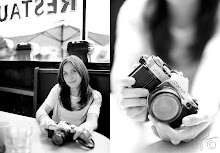The Grand Tour Wraps Up
"After all, the grand tour is just the inspired way of heading home." - Paul TherouxSo this is it. Six months of travel is over and I make my way home to Toronto tomorrow - just in time for Canada Day. It's surreal.
I ended the trip in China with a few relatively uneventful days in rainy Shanghai. A group of us from the hostel drank cheap Chinese beer on the Bund until 4:00 am, watching fireworks and marveling at the pure nastiness of Chinese public toilets. I then spent the last little bit in BC with my family, readjusting to hearing English everywhere, the lack of staring as I walk down the street and the absence of people urinating in public.
A recap of the last six months:# of countries visited: 8 - Japan, Thailand, Cambodia, Vietnam, Laos, India, Tibet and China.Transportation taken: Camels, donkey carts, auto-rickshaws, pedal-rickshaws, taxis, mini-vans, school buses, short buses, airport buses, luxury buses, bullet trains, normal trains, ferries, boats, bicycles, piggyback rides, motorcycles, scooters, countless airplanes, trekking.
Strange Foods Eaten: Slugs, raw horse meat, crickets, scorpions, pigs feet, a large bowl of bones and cabbage, butter tea, yak burgers, black eggs, pretty much everything I ate in China.Highlights: Everest Base Camp, Ankgor Wat, The Taj Mahal, The Great Wall of China, Camel Safari, Japanese Sumo, Laos.Low Points: Sick sick sick in Agra (I left that out of the blog - you didn't need all the details), bombs in Delhi, no Nepal.Animals On Tour: Insane monkeys, pandas, penguins, carp, donkeys, peacocks, dogs, cats, a turtle, camels, elephants, dung beetles, cows, yaks, langoons.
What Has Changed: When I left Toronto it was Christmas. There was snow on the ground. My life was different. Six months later, a lot of things and people have changed. People have gotten engaged and married. Others have moved to new cities, some have new jobs. Some people who seemed important when I left aren't part of my life anymore.What I Learned?: As cliche as it sounds (because you have all heard this speech before), I realize how incredibly fortunate I am for the priviledged life that I live in Canada. I have a family who loves me. I have an amazing group of friends. I have my health and a wonderful education. I have opportunities that people in other countries can only dream about. I have money. I have more than enough to eat. I can afford the luxury of travel. I hope to never have to worry about having a home, finding a job or enough food. I have my freedom. I have hope. After this trip I come home realizing that much of the world doesn't have even a fraction of these things. While I had the most incredible experiences traveling - I saw and did so much - the poor people that I saw everywhere in Asia had the greatest impact on me. In the end, the most important thing that I come home with is a feeling of deep responsibility to the truly destitute people I saw everyday. It seems unfair that we all have so much and that they have so little. So I leave you with a quote from Ghandi that I saw at his house in Delhi."I will give you a talisman. Whenever you are in doubt, or when the self becomes too much with you, apply the following test. Recall the face of the poorest and the weakest man [woman] whom you may have seen, and ask yourself, if the step you contemplate is going to be of any use to him [her]. Will he [she] gain anything by it? Will it restore him [her] to a control over his [her] own life and destiny? In other words, will it lead to swaraj [freedom] for the hungry and spiritually starving millions?Then you will find your doubts and your self melt away."
Me, Mao and His Great Wall
 "If you haven't been to the Great Wall, you aren't a real man." - Mao Zedong
"If you haven't been to the Great Wall, you aren't a real man." - Mao Zedong
Yay. It's official. I am now a real man (I am sure Mao meant man/woman to be interchangeable - at least I am going to interpret it that way). T
he Great Wall. When you put the word "great" into the title of something you set high expectations. Some would have shied away from "great", perhaps opting for "The Ok Wall of China" or the "Don't Get Your Hopes Up Wall of China". Fortunately the Chinese were brave and went with "great". I have to say, the Grea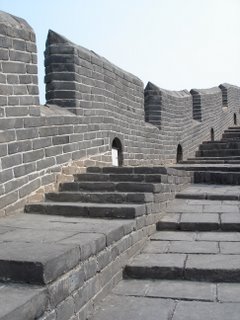 t Wall was one of those rare tourist attractions that live up to its billing. I was prepared to hate the Great Wall but it was incredible.My trip to the Great Wall was even "greater" because of the people who trekked the wall with me - a German couple and two hilarious, gorgeous and incredibly bright guys from the UK (James and Sid you have made your blog debut, did I do you justice?). These people were a constant source of entertainment through the trek, especially considering the heat and strenuous nature of the climb.The section of the wall we hiked was older and had not been restored. It was hilly and difficult to climb. As a result, it was almost empty of tourists. I had envisioned the wall to be flat but quickly discovered that the section we were on required some intense
t Wall was one of those rare tourist attractions that live up to its billing. I was prepared to hate the Great Wall but it was incredible.My trip to the Great Wall was even "greater" because of the people who trekked the wall with me - a German couple and two hilarious, gorgeous and incredibly bright guys from the UK (James and Sid you have made your blog debut, did I do you justice?). These people were a constant source of entertainment through the trek, especially considering the heat and strenuous nature of the climb.The section of the wall we hiked was older and had not been restored. It was hilly and difficult to climb. As a result, it was almost empty of tourists. I had envisioned the wall to be flat but quickly discovered that the section we were on required some intense 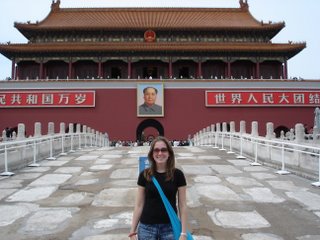 climbing. I pictured thousands of old greying tourists clogging up my shots of the wall. I was prepared for something resembling Disneyland. I was wrong. Throughout the trip we were pretty much only greeted by desperate locals who had climbed to the most challenging portions of the wall and attempted to sell tourists water (makes sense) and, strangely enough, beer (what the???). Despite the hazy day, most of my photos of the wall are void of people, providing you with a general idea of what the wall looked like when it was built.
climbing. I pictured thousands of old greying tourists clogging up my shots of the wall. I was prepared for something resembling Disneyland. I was wrong. Throughout the trip we were pretty much only greeted by desperate locals who had climbed to the most challenging portions of the wall and attempted to sell tourists water (makes sense) and, strangely enough, beer (what the???). Despite the hazy day, most of my photos of the wall are void of people, providing you with a general idea of what the wall looked like when it was built.
The rest of Beijing was interesting, but not as awe-inspiring as the Great Wall. I visited the Forbidden City and Tiannamen S qaure - the centre of the Chinese universe. I'd like to say that I had some compelling story about either one of these icons, but neither one really impressed me all that much. The Mao picture was big. The Square was big. There was a lot of red. There were a lot of imposing stone memorials commemorating the worker. That's about it. The only mildly entertaining thing I saw was a small children in his backless pants (as is the style for all infants here) pissing in the middle of the square (I imagined it to be a political statement on democracy).
qaure - the centre of the Chinese universe. I'd like to say that I had some compelling story about either one of these icons, but neither one really impressed me all that much. The Mao picture was big. The Square was big. There was a lot of red. There were a lot of imposing stone memorials commemorating the worker. That's about it. The only mildly entertaining thing I saw was a small children in his backless pants (as is the style for all infants here) pissing in the middle of the square (I imagined it to be a political statement on democracy).
Perhaps it was a sign that I have been traveling too long. Maybe I had seen too many temples - after a while they start to merge into one giant temple in your mind. Perhaps it was the endless grey days and rain in Beijing. Or it's possible that the crazy tatooed pigs have ruined me for life...nothing will ever impress/baffle me like the pigs. Either way, I left the Forbidden City and Tiannamen Square hoping for something more.
 I think that I am being too hard on Beijing. It might have had more of a chance if it had been my first stop instead of almost at the end of the line. I do have to say though that I met some of the best, most interesting and compelling people of my trip there - wonderfully funny girls who I shared a room with at the hostel, a generous guy from Hong Kong, a sweet Chinese girl trying to learn English and ditch her German boyfriend on late-night phone calls, a beautiful, smart and stylish French girl who made me laugh and, of course, again, the uberwonderful guys from the UK.
I think that I am being too hard on Beijing. It might have had more of a chance if it had been my first stop instead of almost at the end of the line. I do have to say though that I met some of the best, most interesting and compelling people of my trip there - wonderfully funny girls who I shared a room with at the hostel, a generous guy from Hong Kong, a sweet Chinese girl trying to learn English and ditch her German boyfriend on late-night phone calls, a beautiful, smart and stylish French girl who made me laugh and, of course, again, the uberwonderful guys from the UK.
Tatooed Pigs, Slug-eating and Bonecarvers
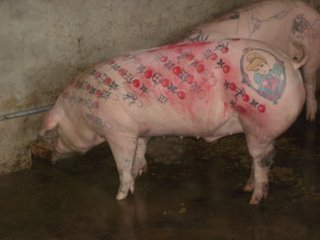 Have you ever seen a tatooed pig? I never thought that I would, but I have now.
Have you ever seen a tatooed pig? I never thought that I would, but I have now.
One of the girls staying in my room in Beijing was a lovely Canadian named Joanie who works for Belgian modern artist, Wim Delvoye. She arranged for me to meet him in Beijing. Wim is best known for "The Cloaca", a piece that actually emulates the human digestive process. The Cloaca machine is fed food and actually produces human shit, which is boxed and sold as art. Check out the Cloaca Web site www.cloaca.be. It's absolutely fascinating. I wish that I had seen it in person when it was in Toronto.Wim was incredibly intriguing, entertaining and bright. I would have to say that he was one of the most interesting people I had the good fortune of meeting on this trip. He had this wonderful sense of whimsy that seems to run through all his art, and his newest project involves tatooing pigs - yes, tatooing...all in the name of art - on a farm in a village outside of Beijing. He told me how he had three types of pigs - classic pigs (with biker tatoos), Disney pigs (with the Little Mermaid and other characters tatooed) and Louis Vitton pigs (wearing this season's Louis Vitton cherry logos). I was lucky enough to spend some time outside the city on the pig farm with Joanie and another girl Fouzia, and I even got to briefly see the pigs themselves. The farm is run by a Chinese man and when we arrived, it was clear that no one in the village spoke English. People were obviously not used to seeing Westerners, but were friendly and waved. Joanie doubled me as we biked to meet a fellow artist in the village, a Chinese man who carves bones, affectionately known to her as "The Bonecarver". Inside his house we were shown photos of the Bonecarver and Mao, and also had the opportunity to see his beautiful work - intricately carved wood boxes and bone vases.
That night we biked into town for a meal. As usual, people stared at the three of us biking past. I don't imagine that they get many foreigners in this village and no doubt they thought that we were associated with the strange Western man who tatoos pigs. In China pigs aren't treated all that well, whereas Wim's pigs are well taken care of. They are well fed, kept warmer than many of the villagers themselves and live in relative luxury when you consider the fate of most Chinese pigs, which is to be crammed into a tiny plot for four months until you are slaughtered.
past. I don't imagine that they get many foreigners in this village and no doubt they thought that we were associated with the strange Western man who tatoos pigs. In China pigs aren't treated all that well, whereas Wim's pigs are well taken care of. They are well fed, kept warmer than many of the villagers themselves and live in relative luxury when you consider the fate of most Chinese pigs, which is to be crammed into a tiny plot for four months until you are slaughtered.
The next morning the Bonecarver inexplicably appeared at the pig farm on his motorcycle and, motioning with his hands, insisted that we come to his house. Baffled, we followed him and were greeted by a clean cut young Chinese man who immediately shoved his resume - all in Chinese characters - into our hands. Unable to understand what was going on because of the language barrier, we assumed that this man was some sort of fellow artisan. The next thing we knew, without any explanation, we were shoved into various positions to have our photographs taken next to art work.
It got even more bizarre when we were seated and served tea. The Bonecarver's wife brought out a large bowl filled with brown items that were unrecognziable to us. She stared eagerly at us, motioning to eat. Joanie, Fouzia and I exchanged looks. No one wanted to eat the mystery brown items, but it seemed rude to refuse. Finally I grabbed one and took a bite.
Whatever it was I was eating had a horrible flavour and texture. It tasted a bit like eating dirt. I smiled at the room full of Chinese people watching us eat and rubbed my stomach in an exaggerated fashion, saying, "Mmmmmmm.." loudly to sh ow my appreciation for their snack. This was obviously the right response because the family smiled and nodded approvingly. Out of the side of my perma-grin mouth I whispered to Joanie, "What the hell am I eating?!?!?!"
ow my appreciation for their snack. This was obviously the right response because the family smiled and nodded approvingly. Out of the side of my perma-grin mouth I whispered to Joanie, "What the hell am I eating?!?!?!"
Joanie spoke a little Chinese and after a few moments we were informed that we were eating dried slugs! I cannot tell you how difficult it became to swallow that mouthful when I realized I was eating a slug, especially with the whole room staring at us. We waited for a moment when everyone in the room wasn't looking at us to slip the partially eaten slugs into our bags. However, seeing we had finished our slugs, the family tried to force more on us, which were also destined for our bags when no one was looking. Finally at one point, when encouraged to take even more slugs, I smile and faked being full indicating, "No thanks! That last slug just filled me up!!"
I came home with a bag full of dried slugs.
Back in Beijing I marveled at my time on the farm. While you all sat at your desks working, I was seeing tatooed pigs, eating dried slugs and modeling for a bonecarver. What a strange, strange ball of dirt we live on.
Lhasa Leftovers
 Just a few random Tibetan moments:1. The only drunk in town - Our last night in Lhasa we headed to a Tibetan bar, which was recommended by our driver. A tough place, inside there were monks drinking in the corner (rough day boys?), loads of Tibetans dressed in bad Western clothes pounding back bottles of Jack Daniels and Tibetan pop performers wailing away on stage. We were greeted with curious stares because we were the only Westerners.
Just a few random Tibetan moments:1. The only drunk in town - Our last night in Lhasa we headed to a Tibetan bar, which was recommended by our driver. A tough place, inside there were monks drinking in the corner (rough day boys?), loads of Tibetans dressed in bad Western clothes pounding back bottles of Jack Daniels and Tibetan pop performers wailing away on stage. We were greeted with curious stares because we were the only Westerners.
After a few Lhasa beers ("The beer from the roof of the world") a filthy sixty year old toothless Tibetan man wearing a cowboy hat sat himself at our table. Not one for buying drinks, the man was carrying a large jug of his own homemade liquor, which he was consuming at an alarming rate. The waitress informed us that he was the town drunk and that they tolerated his presence as long as he behaved himself.
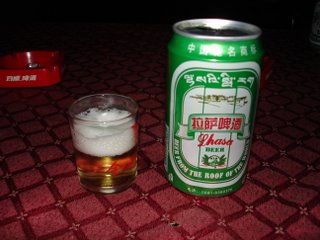 Of course, being the only Western woman in the bar, within five minutes the town drunk had asked me to dance. Now, this was not a bar where people danced. There was a singer on stage, but everyone was seated watching the performance. So when the 60 year old dragged me onto the "dance floor" everyone began to laugh insanely. Me and the town drunk suddenly became the entertainment. How do these people find me?
Of course, being the only Western woman in the bar, within five minutes the town drunk had asked me to dance. Now, this was not a bar where people danced. There was a singer on stage, but everyone was seated watching the performance. So when the 60 year old dragged me onto the "dance floor" everyone began to laugh insanely. Me and the town drunk suddenly became the entertainment. How do these people find me?
2. Yaks - Are they the coolest animal or what? WAY better than penguins. Yaks are now number 1. Reasons why yaks kick ass: a) Yak burgers are the tastiest thing I have ever eaten. I want to start a Yak burger restaurant in Canada.
b) You can ride yaks (at least this is what I have been told - we tried to find one for me to ride, but the farmers we met didn't understand our lame miming) 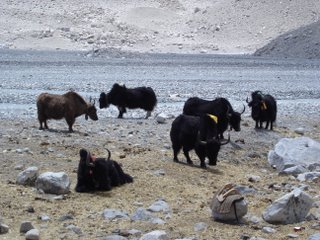
c) Yak butter! Tibetans use this in their tea and at buddhist temples (although, I have to say that butter tea is disgusting). I don't know how they make yak butter but it is awesome.
d) The word yak makes for excellent new slang - "It's yakey!" - something is cool. "Yaki!" - a greeting. "Yak you!" - not a nice thing to say to someone. "It's Yak-tastic!"...
e) Yak fur is incredibly versatile. Yak clothes are going to be the in-thing this fall. Yakinis, yak underwear, yak jeans, yaktinis to drink?....just wait. Can you say trend?
f) Yaks are the hardest working animals in town - not only can you wear their fur, make butter from them, ride them and eat them, you can also plough your farm. So versatile!
3. What is the deal with Tibetan "toilets"? - Easily the worst toilets in the world - they top anything I saw in India, Ecuador or China. These are not toilets. These are black holes of filth and waste. And why does it seem so difficult for the Tibetans to hit the actual holes? No one likes to try to navigate a floor of shit and urine. 
It's certainly an experience when you are in a "bathroom" and there is no door. I now know that it's hard to pee when little kids are staring at you and people are passing you - walking by with their yaks, sitting around staring at you and begging for money.
And, if you are fortunate enough to have a door that sheilds you from the outside world, inside you get to share the hole with everyone. And Tibetans like to watch you pee. It's fascinating to them for some odd reason. I think they wonder if Westerners pee differently than them. Just for the record, we don't. In fact, this forcefully brought home the message that we humans - regardless of race, country and religion - are all the same. How's this for a slogan for world peace - "One world. One way of peeing!"?
Everest Base Camp!!
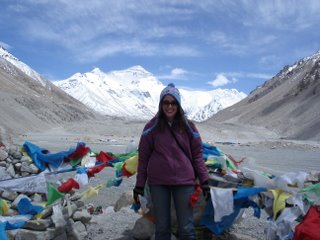 I cannot believe that I have actually been on a mountain, 6,000 meters up. Everest Base Camp was absolutely one of the highlights of my entire trip. Everest itself is stunning from a distance, and becomes even more imposing and beautiful the closer you get.As we drove through mountain passes, climbing up to 5,000 meters, I suddenly felt the effects of the altitude. Arriving at the Rongphu monestary, where we would spend the night sleeping at over 5,800 m, I had a mild headache and it felt like someone was sitting on my chest. After a few deep breaths from the oxygen cans we had brought, I felt better and was ready to start the 7 km trek to Everest base camp.
I cannot believe that I have actually been on a mountain, 6,000 meters up. Everest Base Camp was absolutely one of the highlights of my entire trip. Everest itself is stunning from a distance, and becomes even more imposing and beautiful the closer you get.As we drove through mountain passes, climbing up to 5,000 meters, I suddenly felt the effects of the altitude. Arriving at the Rongphu monestary, where we would spend the night sleeping at over 5,800 m, I had a mild headache and it felt like someone was sitting on my chest. After a few deep breaths from the oxygen cans we had brought, I felt better and was ready to start the 7 km trek to Everest base camp. The path to base camp was empty and as we walked, we passed only yaks, prayer flags and a perfectly clear stream. The mountains around us were massive and ahead, Everest looked massive, despite the fact that we were only 2,000 m from its summit. The entire walk I kept my eyes fixated on Everest's summit. It was even more stunning than I could have imagined and I was surprised at the impact it had on me.Base camp itself was nothing too impressive. Divided into two sections, the first portion is a collection of small tents run by local Tibetans. The second section, cut off to anyone not climbing Everest (a $200 US fine if you enter this portion of the camp), is where the actual climb
The path to base camp was empty and as we walked, we passed only yaks, prayer flags and a perfectly clear stream. The mountains around us were massive and ahead, Everest looked massive, despite the fact that we were only 2,000 m from its summit. The entire walk I kept my eyes fixated on Everest's summit. It was even more stunning than I could have imagined and I was surprised at the impact it had on me.Base camp itself was nothing too impressive. Divided into two sections, the first portion is a collection of small tents run by local Tibetans. The second section, cut off to anyone not climbing Everest (a $200 US fine if you enter this portion of the camp), is where the actual climb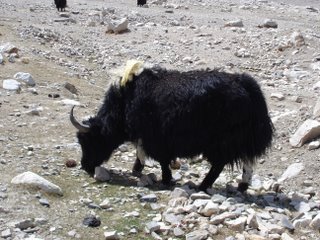 ers are based. Otherwise, base camp is just a large, windy stretch of the mountain, with a view of the summit. We climbed a small hill at base camp to hang some Tibetan prayer flags and spent some time just sitting around in wonder of how high we actually were.Leaving base camp I developed a terrible headache and nosebleed from the altitude. That night was a difficult one because of the altitude and the accommodations. The monestary was basic - to say the least - and the rooms were freezing, despite our sleeping bags. With four of us in the room, all I heard all night was the sound of oxygen being inhaled and people blowing their noses. None of us slept.
ers are based. Otherwise, base camp is just a large, windy stretch of the mountain, with a view of the summit. We climbed a small hill at base camp to hang some Tibetan prayer flags and spent some time just sitting around in wonder of how high we actually were.Leaving base camp I developed a terrible headache and nosebleed from the altitude. That night was a difficult one because of the altitude and the accommodations. The monestary was basic - to say the least - and the rooms were freezing, despite our sleeping bags. With four of us in the room, all I heard all night was the sound of oxygen being inhaled and people blowing their noses. None of us slept.
The next morning, we awoke t o watch the sunrise over the mountain. Leaving, I was struck at the fact that I was sad to go. Over the last few months I have seen so much and passed through so many places that I often don't have time to feel sad when I leave. However, for some reason when I left Everest, all I could think was, "This is the last time I will be here."
o watch the sunrise over the mountain. Leaving, I was struck at the fact that I was sad to go. Over the last few months I have seen so much and passed through so many places that I often don't have time to feel sad when I leave. However, for some reason when I left Everest, all I could think was, "This is the last time I will be here."
Everest was amazing, and despite the small bout of altitude sickness, I still have to say that it was the one of the most incredible things I have ever seen.
Lin-Lin in Lhasa
 From here on in, I will be known as Lin-Lin.
From here on in, I will be known as Lin-Lin.
Apparently my guide in Tibet had a hard time with the name Della and renamed me Rong-Lin (based on my last name). I am told that Lin means "beautiful Jade" and she gave me the nickname Lin-Lin. I wasn't so sure I liked this name. I believe that one of my university roommates' dogs was called Lin-Lin. Sadly, this name stuck and my travel companions in Tibet - Matthaius, Kep Kep and Leo - all liked it and insisted on using it.
The flight into Lhasa was incredible. With the wind ow seat all I could see to the horizon were giant white mountains. Lhasa itself was beautiful. As we drove into town, the Potala palace - perched on a hill overlooking the town - came into our view and it struck me how strange it was to be in Tibet. Suddenly I felt the distance between myself and everyone at home in Canada.
ow seat all I could see to the horizon were giant white mountains. Lhasa itself was beautiful. As we drove into town, the Potala palace - perched on a hill overlooking the town - came into our view and it struck me how strange it was to be in Tibet. Suddenly I felt the distance between myself and everyone at home in Canada.
Our first day in Lhasa was a quiet one because we needed to acclimatize to the nearly 4,000 meter altitude. I didn't feel the altitude, but Matthaius, Kep Kep and Leo all had terrible headaches and we were all exhausted after the early flight and the drive into the city.
On our second day in Lhasa we first toured the Potala palace. It was filled with hundreds of giant golden Buddhas and other Tibetan buddhist shrines. The best part was that the palace is a living monestary and temple. While walking around we were pushed aside by Tibetans who were making offerings to the various Buddhas and stupas. They prayed, lit candles and made offerings of money to the Buddhas they saw. Outside, groups of pilgrims pushed the prayer wheels and threw themselves on th e ground in prayer.
e ground in prayer.
We then visited the Jokhang Temple/Monestary. Located in the middle of town, large groups of monks dressed in heavy maroon robes sat around in groups. We were told that these monks had come from all over Lhasa to debate issues related to Buddhism and to sit exams. Inside the monestary, we were lucky to see the arrival of a high-ranking Lama. The monestary was shut to visitors, but since we were already inside they permitted us to stay. Monks were dressed in their full outfits, including their hats, and had decorated the courtyard with paintings of Buddhist symbols. As the Lama arrived, they played their horn and rushed over to greet the old man.
The rest of our time in Lhasa was spent wandering the Barkhor market that surrounds the monestary. Pilgrims circle the monestary in prayer and along the circuit there are vendors selling everything from clothes to stuffed yaks. 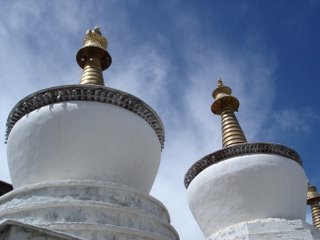 The next morning we set out for a long drive through mountains and past green rivers to Shigatse, the home of the Panchen Lama. We again toured beautiful, ornate monestaries and I learned a lot about the Tibetan Buddhist religion. Our next day was an epic drive, offroading in our 4X4 through dirt paths, across streams and rivers and through tiny Tibetan villages filled with identical whitewashed homes. Arriving in Tingri, just a short distance from Everst, we were surprised to see that it was just one road lined with shops and a handful of guesthouses. The scenery of Tibet is gorgeous and the closer we got to Everest, the more exicited the group of us got, despite the fact that it was colder and the altitude higher, causing some of us to be sick.
The next morning we set out for a long drive through mountains and past green rivers to Shigatse, the home of the Panchen Lama. We again toured beautiful, ornate monestaries and I learned a lot about the Tibetan Buddhist religion. Our next day was an epic drive, offroading in our 4X4 through dirt paths, across streams and rivers and through tiny Tibetan villages filled with identical whitewashed homes. Arriving in Tingri, just a short distance from Everst, we were surprised to see that it was just one road lined with shops and a handful of guesthouses. The scenery of Tibet is gorgeous and the closer we got to Everest, the more exicited the group of us got, despite the fact that it was colder and the altitude higher, causing some of us to be sick.
Panda-mania in Chengdu
 Do you remember the sex ed video from grade 9 gym class called "The Miracle of Birth"? For those of you who haven't seen it, it's a dated educational video that features, above all else, a disturbing close-up of a live birth. It had the effect of inducing groans of "ewwwww gross!" and "ouuuuchhhhh!" from the group of 14-year-old girls in my gym class and, at least briefly, had us all pledging to never have sex. It was a dose of video birth control.
Do you remember the sex ed video from grade 9 gym class called "The Miracle of Birth"? For those of you who haven't seen it, it's a dated educational video that features, above all else, a disturbing close-up of a live birth. It had the effect of inducing groans of "ewwwww gross!" and "ouuuuchhhhh!" from the group of 14-year-old girls in my gym class and, at least briefly, had us all pledging to never have sex. It was a dose of video birth control.
I was again reminded of this film, as I sat through the panda equivalent of it at the Panda Breeding Centre in Chengdu, China. And if I ever wondered why pandas were an endangered species, I don't anymore after seeing this disturbing video.
 I watched in disgust as a gross, pinkish, alien-looking creature shot out of the mother panda's vagina and began screeching in a violent way. This caused the mother panda to literally jump across the cage in fear (I think that I would do the same if that thing suddenly shot out of my vagina). Panicking, and apparently unable to identify this rat-like animal as its offspring, the mother began violently batting the baby panda around the cage like a beachball before it was saved by the centre's caregivers. The video informed us that this is apparently a common reaction because most females are surprised when they give birth the first time. No wonder so few pandas exist in the wild.The pandas themselves were quite cute. I spent the morning watching them in their enclosures eating bamboo, sleeping and even take a shit. Apparently they don't do much more than that. Sometimes they have sex, which the Chinese always refer to as "panda marriage", as if though the panda, like humans, should be incapable of reproducing unless they are married. I didn't see any live panda sex shows, but t
I watched in disgust as a gross, pinkish, alien-looking creature shot out of the mother panda's vagina and began screeching in a violent way. This caused the mother panda to literally jump across the cage in fear (I think that I would do the same if that thing suddenly shot out of my vagina). Panicking, and apparently unable to identify this rat-like animal as its offspring, the mother began violently batting the baby panda around the cage like a beachball before it was saved by the centre's caregivers. The video informed us that this is apparently a common reaction because most females are surprised when they give birth the first time. No wonder so few pandas exist in the wild.The pandas themselves were quite cute. I spent the morning watching them in their enclosures eating bamboo, sleeping and even take a shit. Apparently they don't do much more than that. Sometimes they have sex, which the Chinese always refer to as "panda marriage", as if though the panda, like humans, should be incapable of reproducing unless they are married. I didn't see any live panda sex shows, but t here were photos of panda porn on signs scattered throughout the park, many of them including graphic descriptions of panda mating habits.
here were photos of panda porn on signs scattered throughout the park, many of them including graphic descriptions of panda mating habits.
So you are of course wondering where pandas now rate on my animal scale. Well, it's still penguins at #1, but pandas come in a close second (namely because none of them attacked me or farted on me), with camels and monkeys rounding out the end of the list.
I Met My Boyfriend at IKEA Tokyo
 Yes, that is a photo of me and a Japanese man who is either asleep, but more likely drunk (note the beer).
Yes, that is a photo of me and a Japanese man who is either asleep, but more likely drunk (note the beer).
Now, a sleeping or drunk Japanese man is not particularly noteworthy on his own. They are always sleeping or drunk on the subway here. However, what is of interest is that the photo of the passed out man was taken at IKEA in Japan. Not the ideal place to get trashed, but he seemed to be enjoying it.
Sandra, Jay and I decided to visit Japan's first IKEA the week it opened. Talking to a staff member, we were told that at 9:30 am the day of the store's grand opening, not a single person was in line. He admitted that at that point IKEA executives began to panic, but they were relieved when at 9:50 am over 4,000 were in line. By end of day one over 35,000 IKEA-loving Japanese had cruised through the store.
Now, you're probably asking why we went to IKEA since we have IKEA in Canada. Mainly we went because I love any opportunity to watch the Japanese whip themselves into anything resembling a fury. Strangely, this never seems to happen. Calm and compliant behaviour is the norm here, but I must say that the IKEA experience was as close as I have seen any of the Japanese get to any sort of frenzied behaviour. I guess that cheap furniture does that to people, especially in a country where it is not uncommon to pay $300 (Cdn.) for two gift melons.
I was also excited to see if IKEA in Japan was any different than IKEA in Canada, and I was pleasantly surprised to see a nice mix of consistency and differences.
Things That Are EXACTLY the Same at IKEA Japan and IKEA Canada 1. Snake Pit - Scary oversized stuffed snakes that make you wonder who buys these things.
1. Snake Pit - Scary oversized stuffed snakes that make you wonder who buys these things.
2. Same Old, Same Old - Same couches, tables, curtains, shelves and accessories.
3. But All I Wanted Was a Candle... - Same oversized bags for you to carry all the crap that you didn't mean to buy when all you really wanted was a throw pillow, a cool dish and a few Swedish meatballs. Like you REALLY needed that blanket that doubles as a dart board.
4. Getting Lost - The mazelike layout, including arrows to direct people (not required because the Japanese are not prone to trying to "go against the flow" in any sense), ensure no escape until you've seen the whole store.
Things That Are KINDA the Same at IKEA Japan and IKEA Canada...But Not Really1. Kiddie Holding Pen - Known as the ballroom in Canada, in Japan it is called Smiletown. Basically the two are the same -one room filled with screaming children jumping in vats of large plastic balls which are probably coated in a thin layer of urine.
I am also sure that, just like in Canada, in Smiletown there is at least one six-year-old girl stealing balls, frantically stuffing them into her snowsuit when staff members aren't looking, because her father told her that, "If every time we go to the IKEA ballroom you take at least one ball home with you, soon you will have your own ballroom in the basement." Oh wait...maybe that was just at the Nepean IKEA...DAD!
Being a ballroom connaiseur myself, I thought that the Japanese room was nicer, primarily because it is new and likely relatively urine-free...for now.
2. IKEA Loonie Dogs - In Japan these things cost 100 Yen, which is the equivalent of a Canadian dollar. This is where the similarity ends. I had to buy a ticket from a small vending machine-like device to exchange for the 100 Yen Dog. I then had to proceed to strange ketchum and mustard dispensing udders that hung from the ceiling.
And yes, this thing looked absolutely disgusting but -this will come as no surprise to those who know me well enough to know that I am always eating - I ate it anyway because I was hungry.
3. IKEA cafeteria - Just like at home, the IKEA Japan cafeteria serves up what I assume is Swedish comfort food, including Swedish meatballs, salmon and reindeer (ok fine, no reindeer, but that's what I picture the Swedes eat every day at home).
In the Ottawa and Toronto stores the cafeterias are relatively small, but in Japan the cafeteria is enormous. The day we were there it was filled with young Tokyo-dwellers chowing down on full meals of Swedish foods- meatballs, rice, potato, salad, buns, deserts and beer?? Since when do people drink at IKEA? And who would think of drinking so much there that they actually passed out?
In Canada I always thought of the IKEA cafeteria as a place where people stopped only if they became lost in the store, stopping briefly for directions to the exit and to eat meatballs to restore their energy for the marathon trek out. In Tokyo the people we saw seemed genuinely excited for a full IKEA meal and didn't seem to mind spending money to get it (soooo expensive!!). In Japan, I guess that Swedish food is hip. In fact, I actually think some people came to IKEA just for the cafeteria food. Since when did it become cool to eat at IKEA?
Things That Are TOTALLY Different Between IKEA Japan and IKEA Canada
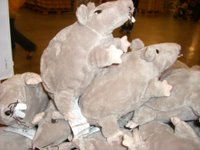 1. IKEA Japan Fornicating Stuffed Rats - Not sure why stuffed rats would be a big seller at IKEA in Japan, especially when positioned having sex in a large bin of other stuffed rats...like a stuffed rat orgy.
1. IKEA Japan Fornicating Stuffed Rats - Not sure why stuffed rats would be a big seller at IKEA in Japan, especially when positioned having sex in a large bin of other stuffed rats...like a stuffed rat orgy.
I also wonder why we don't have them in Canda. I assume this item did not test well in the Canadian market. Parents' comments probably included feedback like, "Humping rats are not ideal toys for my child!" or "The new IKEA Kaamoi Suitraa Rats are not funky enough for my kid."















 From here on in, I will be known as Lin-Lin.
From here on in, I will be known as Lin-Lin.








